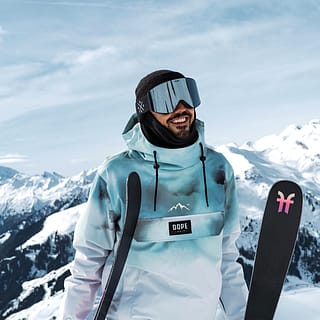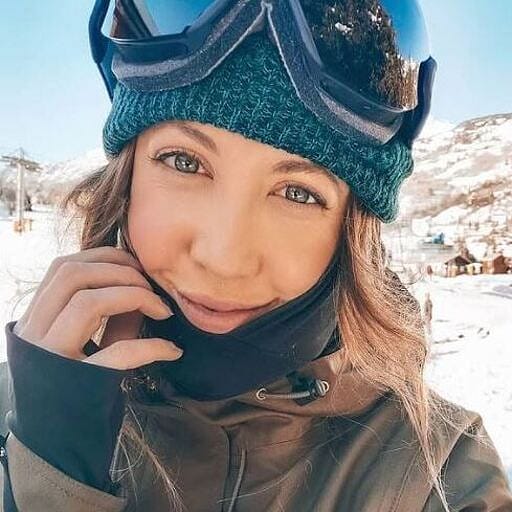Ski slope ratings explained
You’ve made it to resort — congrats! Now, you’re looking at the trail map, wondering which runs to take. What do all the colors mean? And are they the same across North America and Europe? Don’t fear — Dope Mag’s here with our ski slope ratings guide.

Spoiler alert: the different colors on a resort map showcase ski trail ratings. And each color indicates each trail’s difficulty level. None other than the Disney Company influenced this decision in the 60s after creating a three-tier scale for a ski resort project. In 1968, the National Ski Areas Association switched its system to Disney’s so US riders could identify differences and difficulties no matter the resort.
Don’t worry if you’re new to the topic — but maybe hold off on tackling a black diamond until you are! Whether you’re skiing in North America, Europe, or beyond, Dope Mag’s got you covered with a foolproof, quick-fire guide. Oh, and speaking of colors, why not express yourself through our latest collection? It’s full of new shades and prints to look fire on every trail.
Understanding levels and colors of resort terrain
How are slopes rated?
Although we have the National Ski Areas Association (NSAA) system, each slope is classified in relation to others within a particular ski resort or region. Basically, slopes aren’t uniformly calibrated across each US state or the globe. So, a black diamond in a New Hampshire ski resort might differ greatly from one in Colorado. And a green circle somewhere like J-Hole can potentially feel the same as a blue in Serre Chevalier, France.
But how does each resort rate its trails? It’s all down to the gradient. Slope angles are measured in percentage rather than degrees, with 100% representing a 45-degree angle. And most trails are rated by their steepest and trickiest sections. With all that in mind, let’s get into North America’s green-blue-black trifecta, how this differs from Europe, and what each slope rating means.
North American trails

Green circle
Green circles have a gradient between 6 and 25% and are designed for beginners. These are the easiest trails, often gentle, wide, and well-groomed. When you’re super new, you might start on the bunny hill, though. This is a separate, dedicated area for mini shredders or beginners. Bunny hills are usually at the resort’s base for easy access and have their own learner-friendly lifts.
As you progress, you’ll notice greens all over the mountain. These runs have groomed, compact snow to help you find your groove. Although some greens wind through the trees, most are fairly wide, so everyone has enough room to nail the basics. Greens deliberately have a mellow gradient so you can control your speed and take your time learning falling leaf or snowplough turns. And once you’ve mastered beginner terrain, it’s time for the blues.
Blue square
Blue squares ramp up the gradient a bit (between 25% and 40%). This extra steepness means intermediates can gain more speed with their turns and level up their skills faster. Unless you’re hitting corduroy first thing, blues might also feature less-than-ideal snow conditions, and even ice or bumps by the afternoon. Don’t worry — riding different types of snow is part of progressing.
Blue slopes cover a variety of terrain. For example, some are mega-fun, wide, and cruisey — perfect for warmup laps and letting loose. Others might feature narrow sections and tight turns. Encountering different blues forces you to try new techniques and gain enough confidence to handle the steeper stuff.
Black diamond
Reach black diamond level — aimed at high intermediates and advanced riders — and things get gnarlier. The gradients become spicier (over 40%), and the features take no prisoners. So, expect bumps and ungroomed steep sections. Black diamonds can also be narrow in places, so make sure you’re mega-confident with tight turns before attempting.
Most black runs are still accessible to intermediates looking for a challenge. Plus, they’re rarely one type of terrain all the way down. For example, a black that’s steep at the top can mellow midway, and bumps sometimes transition into smoother sections. This variety works your legs and your skills — and makes black diamonds some riders’ trail of choice.
Double black diamond
Pro-level? Reckon you can drop into Corbet’s Colouir no probs? Double black diamonds are for you! Okay, a double black probably isn’t miles more challenging than a standard black (although gradients can be +40%). However, at least one section requires expert technique, such as dominating trickier turns, wilder terrain, or near-vert drops *gulp*.
Double black diamonds are typically off-piste, ungroomed, and unpredictable. So, be ready to handle cliffs, steep icy sections, couloirs, and whatever else the mountain throws at you. Yep, double black diamonds aren’t exactly a walk in the park. They’re super fun to conquer once you know your stuff, though.
Other resort ratings
You might spot extra symbols on terrain maps, especially in North America — like red dashes for ungroomed, off-piste areas. And watch for quirks: at Utah’s Alta Ski Area, a single black diamond can be as gnarly as a double black elsewhere. Keeps you on your toes (and hopefully on your skis).
This isn’t an exhaustive list, but here are a few more to know…
Double blue square
Head to Jackson Hole in Wyoming (a bucket-list-worthy resort, if you ask us), and you’ll most likely spot a double blue square symbol. This shows that the corresponding trails are trickier than one-square blues, but not as challenging as a black diamond. Our fave double blue square? It has to be Hanging Rock!
Triple black diamond
Okay, this rare rating puts the fear of God into most mortals. Yep, these slopes are mega steep, hella rocky, typically host a stomach-churning drop or two, and require a gnarly traverse or heart-thumping hike to access. The gradient can also reach 90% *shudders*. Prep yourself for a few triple blacks when heading to Montana’s Big Sky Resort.
Extreme terrain
If you spot a double black diamond symbol with ‘E’ and ‘X’ in the diamonds, you know this trail means serious business. Yep, this signifies ‘extreme terrain’ (mostly found in Colorado). These runs are typically more dangerous than double blacks, with features such as no-fall zones, super tight couloirs, unmarked rocks, and more.
Orange rectangle
Orange represents freestyle, showing where you can find a terrain park and/or halfpipe. Terrain parks often have their own rating system. For example, beginner to expert. Jump lines have different ratings, too, signifying how difficult and technical the obstacles are. They progress from XS to XL, with an XL line including pro-level kickers.
European slopes

Europe uses a color-coded circle system to rate slopes, too. This system is similar to North America, with greens being for beginners and blues for more experienced beginners and intermediates. However, in Europe, progressing past the blues means tackling red and black runs instead of diamond-graded trails. Basically, reds are for advanced riders and blacks for experts.
Let’s check out the full list and gradients below:
- Green circle = beginners
- Blue circle = beginners and intermediates (less than 25% gradient)
- Red circle = intermediates (less than 40% gradient)
- Black circle = advanced and experts (over 40% gradient)
Some resorts across Switzerland, France, and Austria include an orange circle to represent extremely difficult terrain (trickier than black runs). One example is the terrifying Swiss Wall on the French-Swiss border. On rare occasions, you might spot a yellow circle or red diamond (or an orange square in Austria). These symbols signify ungroomed, unpatrolled routes, such as Verbier’s iconic (and fearsome) Tortin slopes.
Slope ratings around the world
Widening your shred net? Some ski resorts outside the US and Europe have different slope ratings. Don’t get caught out, though. Instead, check out our mini roundup below.
Oh, and remember that each ski resort rates its own slopes. So, prep for varying degrees of difficulty as you ride from the French Alps to Niseko (you lucky thing!). Heading to Australia or New Zealand? These typically follow the same trail rating system as North America! Handy, right?
Scandinavia
- Green circle = beginners (up to 16% gradient)
- Blue square = beginners (up to 27% gradient)
- Red rectangle = intermediates (up to 47% gradient)
- Black diamond = upper intermediates and advanced (over 47% gradient)
- Double black diamond = advanced and experts (over 47% gradient)
Japan
- Green circle = beginners
- Red circle = intermediates
- Black circle = advanced and experts
Wrapping up
Slope ratings exist as your guide to having a great day on the mountain. Without them, it’d be like Russian Roulette and total guesswork as to whether your descent will be leisurely or next-level gnarly. We don’t know about you, but we like knowing what we’re getting into! Shall we cruise the blues or push ourselves on the steeps?
Have more questions about colors, shapes, and trail maps? Or just want to chat with someone about all things snow? Reach out to our super-friendly team of experts at crew@dopesnow.com. We’ll see ya on the mountain!
Related reading:


